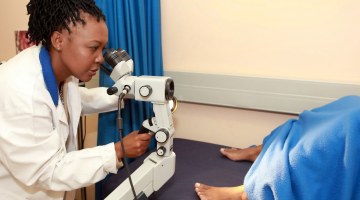viaAllAfrica, interview with Professor Salim Abdool Karim
 Professor Salim Abdool Karim, director of the Centre for the AIDS Program of Research in South Africa (Caprisa) at the University of KwaZulu-Natal and Columbia University in the United States, spoke to AllAfrica's Julie Frederikse about the unexpected halt of a study into tenofovir vaginal gel. This followed a finding that the microbicide failed to prevent HIV transmission, in contrast to the positive result in a previous study conducted by his Caprisa team.
Professor Salim Abdool Karim, director of the Centre for the AIDS Program of Research in South Africa (Caprisa) at the University of KwaZulu-Natal and Columbia University in the United States, spoke to AllAfrica's Julie Frederikse about the unexpected halt of a study into tenofovir vaginal gel. This followed a finding that the microbicide failed to prevent HIV transmission, in contrast to the positive result in a previous study conducted by his Caprisa team.
What happened when you heard the findings of the new study that contradicted your results?
We were surprised and very disappointed. We know that science doesn't always give you the answers you want and hope for, but when you look at the totality of the evidence, we know that there's still pretty strong evidence, whether from the laboratory or in monkeys or in humans, that tenofovir gel is effective in preventing HIV. This is rationale for why the Caprisa and Voice (Vaginal and Oral Interventions to Control the Epidemic) studies were conducted in the first instance. So now we need to understand why the Voice trial produced a different result.
Is this a big setback to Caprisa's research?
The Voice trial is an important result. We now need to understand it. It doesn't take us completely off track - it's a temporary setback - and understanding this result would put us in a better position to move forward again. Science grows not only from success, it also grows from failure.
Has the suspension of this study demoralised your team?
That's the nature of science. In a series of studies, it is seldom that every study shows the same thing. But we'll stay on track, and try and understand why the Voice result is different. Whether the women in the study were not using the gel correctly, or there were other underlying problems, we don't know yet. It's too early to tell.
Read the rest.
[If an item is not written by an IRMA member, it should not be construed that IRMA has taken a position on the article's content, whether in support or in opposition.]
 Professor Salim Abdool Karim, director of the Centre for the AIDS Program of Research in South Africa (Caprisa) at the University of KwaZulu-Natal and Columbia University in the United States, spoke to AllAfrica's Julie Frederikse about the unexpected halt of a study into tenofovir vaginal gel. This followed a finding that the microbicide failed to prevent HIV transmission, in contrast to the positive result in a previous study conducted by his Caprisa team.
Professor Salim Abdool Karim, director of the Centre for the AIDS Program of Research in South Africa (Caprisa) at the University of KwaZulu-Natal and Columbia University in the United States, spoke to AllAfrica's Julie Frederikse about the unexpected halt of a study into tenofovir vaginal gel. This followed a finding that the microbicide failed to prevent HIV transmission, in contrast to the positive result in a previous study conducted by his Caprisa team.What happened when you heard the findings of the new study that contradicted your results?
We were surprised and very disappointed. We know that science doesn't always give you the answers you want and hope for, but when you look at the totality of the evidence, we know that there's still pretty strong evidence, whether from the laboratory or in monkeys or in humans, that tenofovir gel is effective in preventing HIV. This is rationale for why the Caprisa and Voice (Vaginal and Oral Interventions to Control the Epidemic) studies were conducted in the first instance. So now we need to understand why the Voice trial produced a different result.
Is this a big setback to Caprisa's research?
The Voice trial is an important result. We now need to understand it. It doesn't take us completely off track - it's a temporary setback - and understanding this result would put us in a better position to move forward again. Science grows not only from success, it also grows from failure.
Has the suspension of this study demoralised your team?
That's the nature of science. In a series of studies, it is seldom that every study shows the same thing. But we'll stay on track, and try and understand why the Voice result is different. Whether the women in the study were not using the gel correctly, or there were other underlying problems, we don't know yet. It's too early to tell.
Read the rest.
[If an item is not written by an IRMA member, it should not be construed that IRMA has taken a position on the article's content, whether in support or in opposition.]














